How do blood vessels get damaged?
Let’s first look at how blood vessels can get damaged.
As we grow older, we experience growing consequences from a range of risk factors that we may be exposed to: high blood pressure (also known as hypertension), high cholesterol, smoking, toxins, inflammation, and other aging processes.
Over time, these risk factors can damage blood vessels. I have made this illustration to show two types of damage to blood vessels: atherosclerosis and aneurysms. These conditions are part of – or can lead to – other cardiovascular diseases.
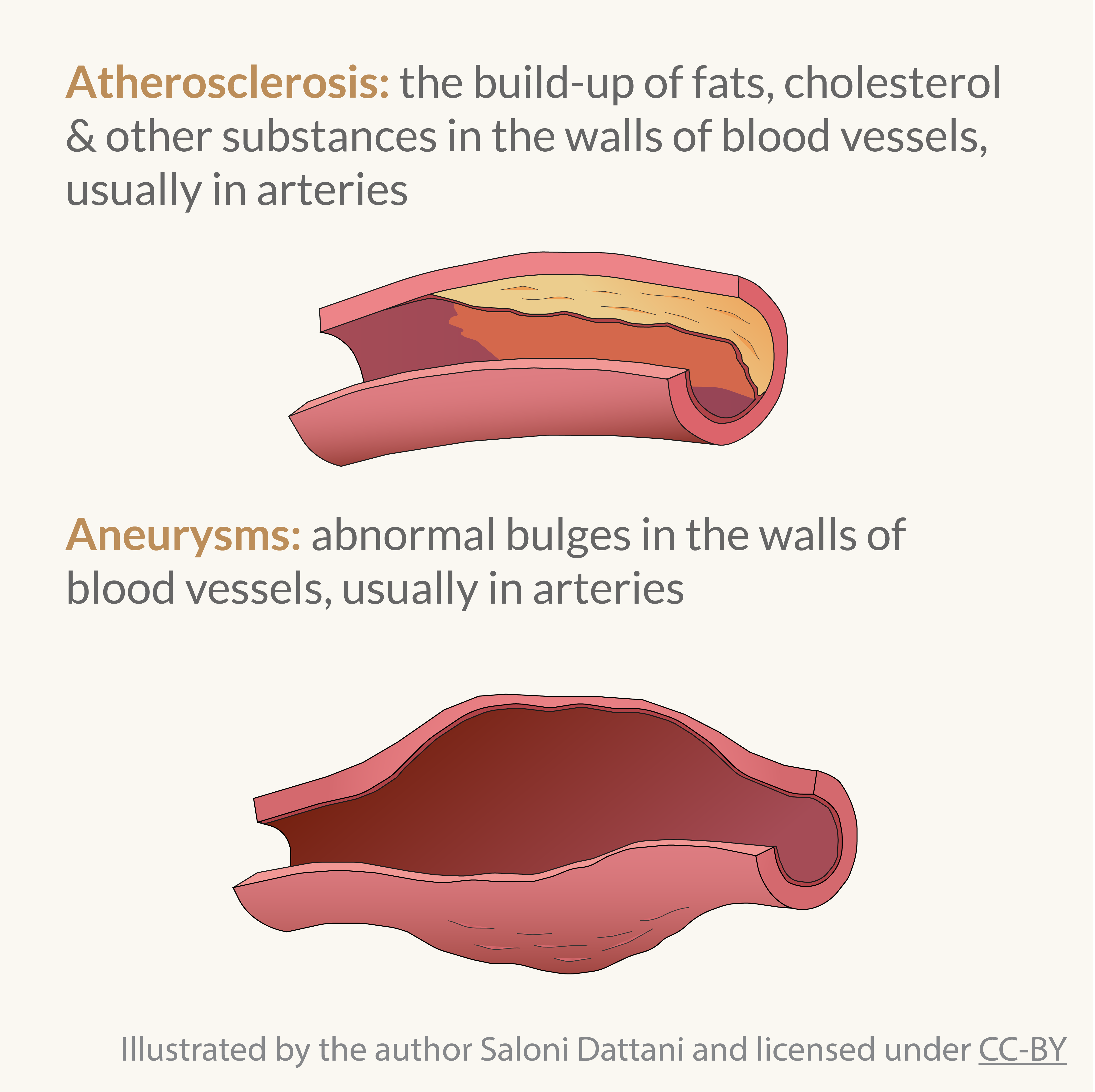
In atherosclerosis, there is a build-up of fats, cholesterol, and other substances in the walls of blood vessels, usually in arteries (which carry oxygen-rich blood away from our heart and towards our organs). This build-up narrows the space for blood to travel through and limits blood flow to organs.
Sometimes, the build-up can be unstable and can break off from the blood vessel. This can be dangerous, as it can travel through the bloodstream and cause a blood clot to form around it. The clot can then get stuck in smaller blood vessels and cut off blood flow to parts of the body.3
In aneurysms, the walls of blood vessels weaken, which makes the vessels bulge out, and their walls stretch thinner. Aneurysms can develop due to high blood pressure, atherosclerosis, injuries, and other risk factors.
In serious cases, an aneurysm can lead to the tearing or breaking of a blood vessel, which leads to bleeding in the surrounding area and reduces blood flow to other organs, which can cause organ damage.
Diseases of the heart
The heart is the central part of the cardiovascular system: it is a powerful muscle that keeps blood pumping. Because of this, damage to the blood vessels to the heart, or the heart muscles, can affect the whole body.
The illustration below shows the basic structure of the heart and some major diseases of the heart. Below, we’ll look at each of them and look at the death rates across the world from these diseases.
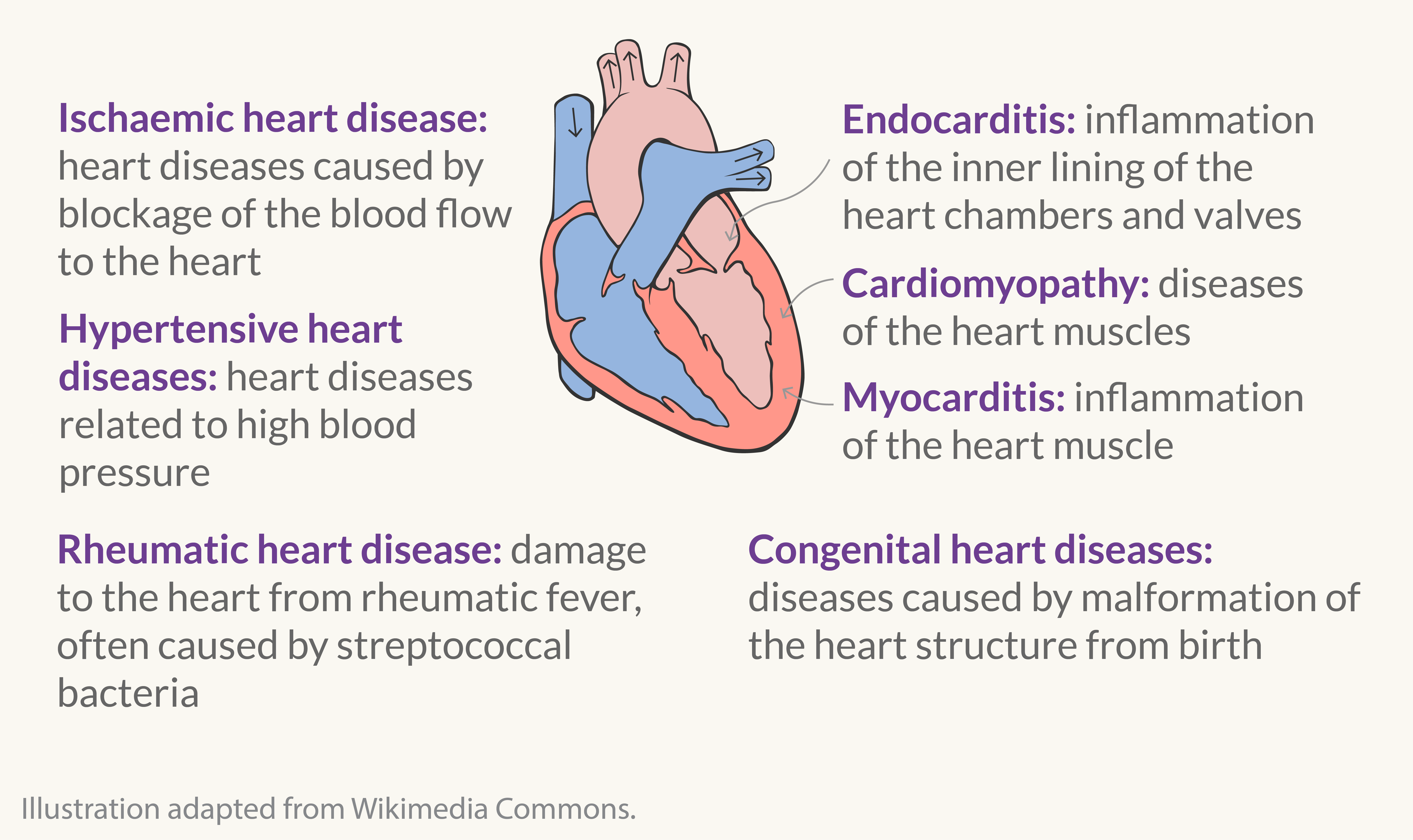
Ischemic heart disease, also known as coronary artery disease, is the most common cause of cardiovascular deaths globally. It develops when there is a blockage of blood flow to the heart, often due to atherosclerosis.
Without proper management, ischemic heart disease can lead to complications such as heart attacks, angina, and silent ischemia.
Heart attacks, which are formally called “myocardial infarctions” in medicine, are when heart muscle cells die from a lack of blood flow, inflammation, or injury to the heart, and can lead to heart failure and death.4
Angina is chest pain or discomfort caused by insufficient blood flow to the heart. There are two types of angina. “Unstable angina” develops suddenly and is a medical emergency as it increases the risk of a heart attack, while “stable angina” tends to be more predictable – often occurring after exercise or stress – and goes away after rest or medicine.
Silent ischemia is when the heart muscle is damaged by a lack of blood flow, but the affected person doesn’t experience the typical symptoms of chest pain or discomfort, which makes it more difficult to recognize.
The map shows the estimated death rate from ischemic heart disease around the world. The death rate is age-standardized, which makes it comparable across different countries and over time.
As you can see, the death rate tends to be higher in Africa and Asia than in Europe and North America. These differences arise from differences in risk factors – such as smoking, alcohol, hypertension, poor diet, and air pollution – and lower healthcare access and resources for screening and treating cardiovascular diseases.5
Congenital heart diseases develop from heart abnormalities that are present at birth when the heart structure doesn’t form properly during fetal development.15
Diseases of the brain’s blood vessels
The illustration below shows the blood supply to the brain and some major conditions of the brain’s blood circulation system.
Cerebrovascular diseases are a broad category of diseases that affect the brain's blood vessels. This includes aneurysms, which we saw earlier, and strokes.
In a stroke, blood supply is reduced to the brain. This can have serious medical consequences: as we saw earlier, the brain is particularly vulnerable to a lack of blood flow.
Since the brain controls many body parts and is highly active, it requires a continuous supply of oxygen and nutrients. Even a brief interruption of blood supply to the brain can cause cells to function improperly or die, leading to cognitive impairments.
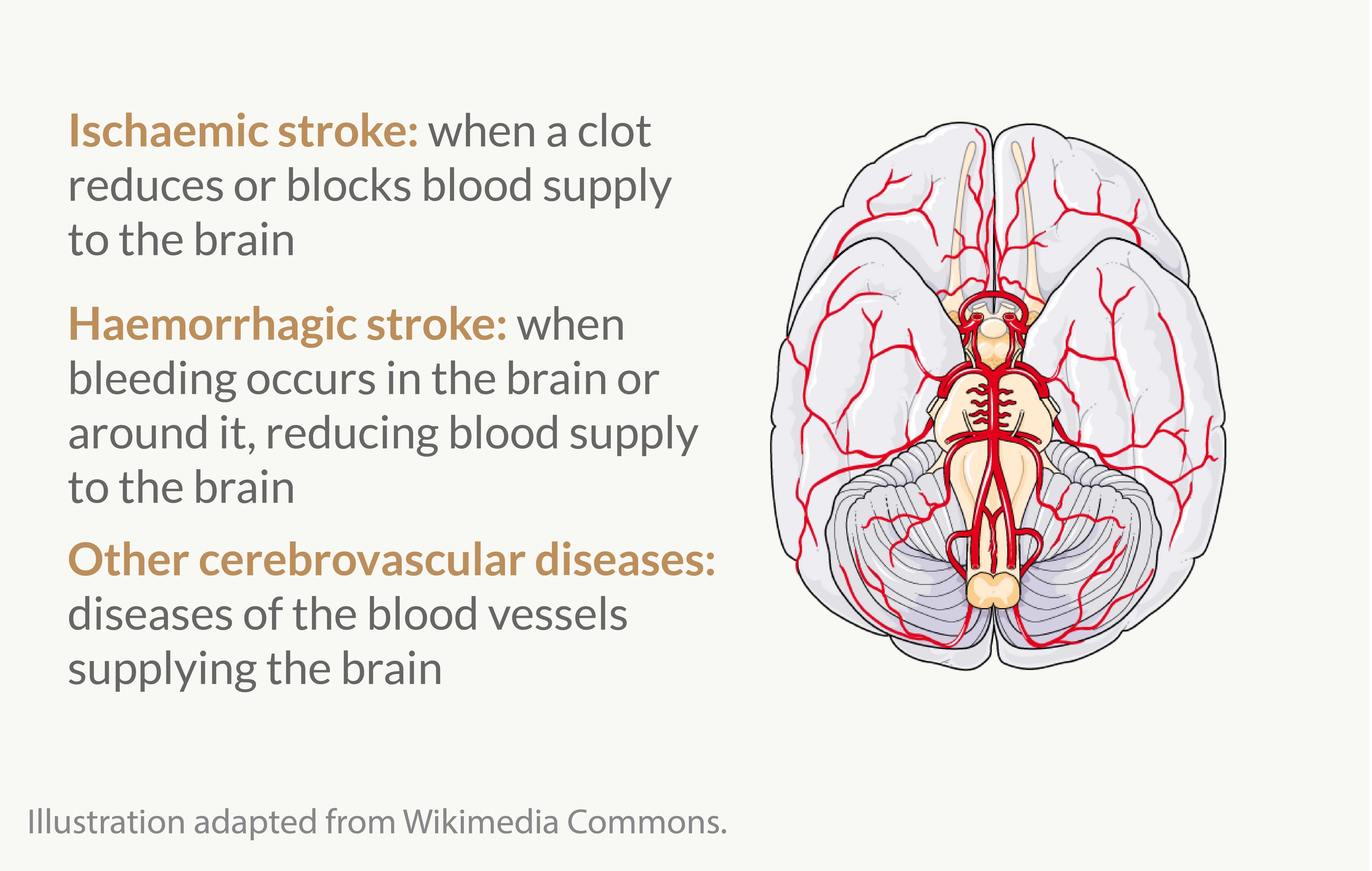
Diseases of blood vessels in the lungs and other parts of the body
Diseases of the blood vessels can also affect the lungs and other body parts, as you can see in the illustration below.
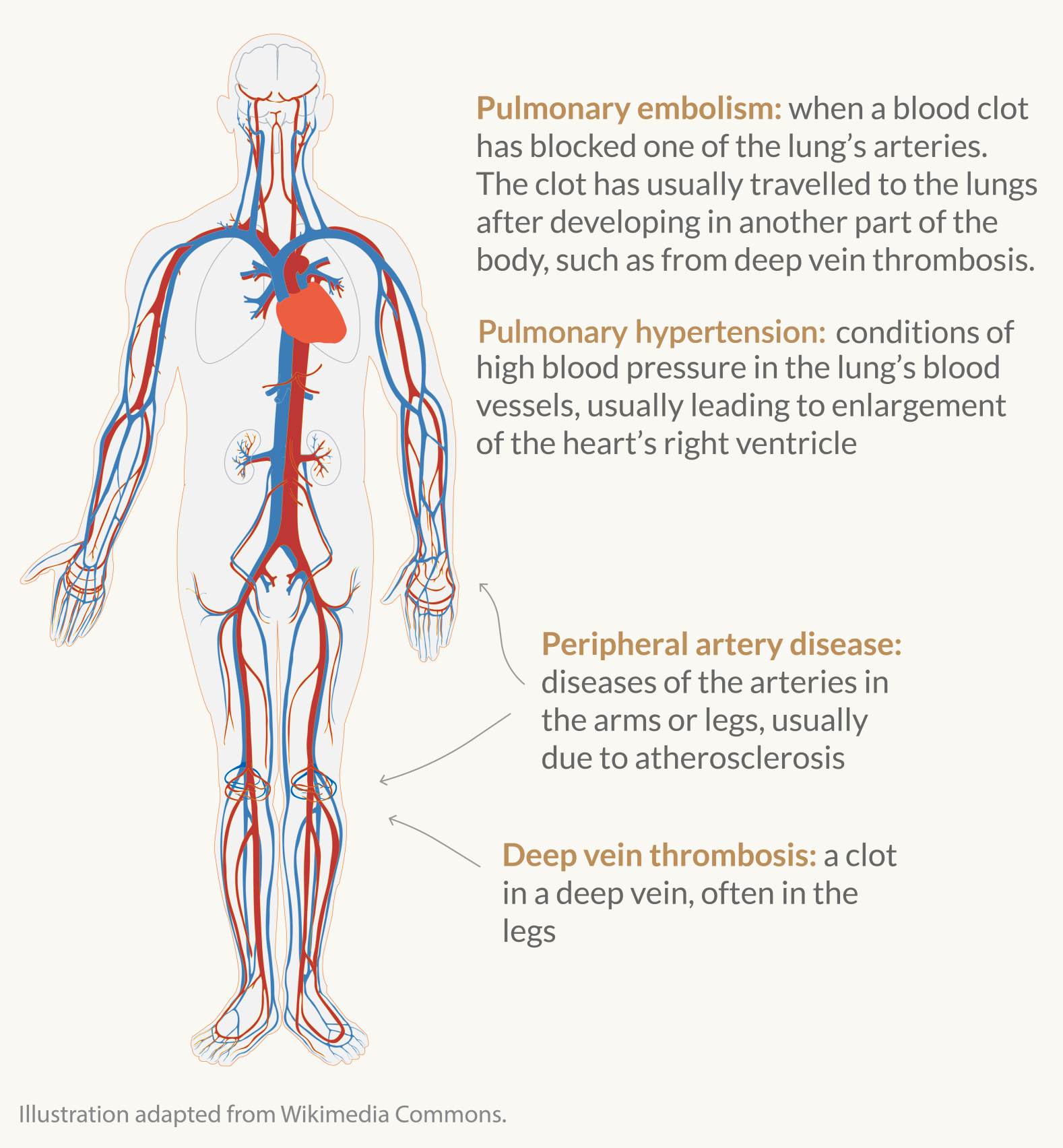
Peripheral artery disease develops when narrowed arteries reduce blood flow to the arms or legs. It's typically caused by atherosclerosis.18
Deep vein thrombosis (DVT) develops from blood clots in a deep vein, usually in the legs. While some people don’t experience symptoms, others have pain and swelling. Deep vein thrombosis can also be a serious risk if the blood clot breaks off and travels to other parts of the body – especially if it travels to the lungs and blocks off its blood supply.19
Pulmonary embolism is a condition when a blood clot has blocked one of the lung’s arteries. It can develop as a direct consequence of deep vein thrombosis. This is because the clot has usually traveled to the lungs after developing in another part of the body, such as from deep veins in the legs.
Pulmonary hypertension is a condition of high blood pressure in the blood vessels to the lungs, which usually involves enlargement of the right ventricle of the heart. It can develop from diseases of the lung’s arteries, or other heart or lung conditions, such as chronic obstructive pulmonary disease (COPD).
These other diseases are often classified under ‘other circulatory diseases’ in estimates of death tolls.
Conclusion
Cardiovascular diseases are a group of related diseases that have a large impact on global health. They are the leading cause of death worldwide.
Ischemic heart disease and strokes – both ischemic and hemorrhagic strokes – cause the greatest number of deaths globally. But hundreds of thousands also die annually from other preventable conditions, such as rheumatic heart diseases.
By understanding these conditions, their risk factors, and the blood circulation system, we will be better able to prevent and treat these conditions and reduce this major cause of global mortality.
In the illustration below, I have summarized all the conditions described in this article.
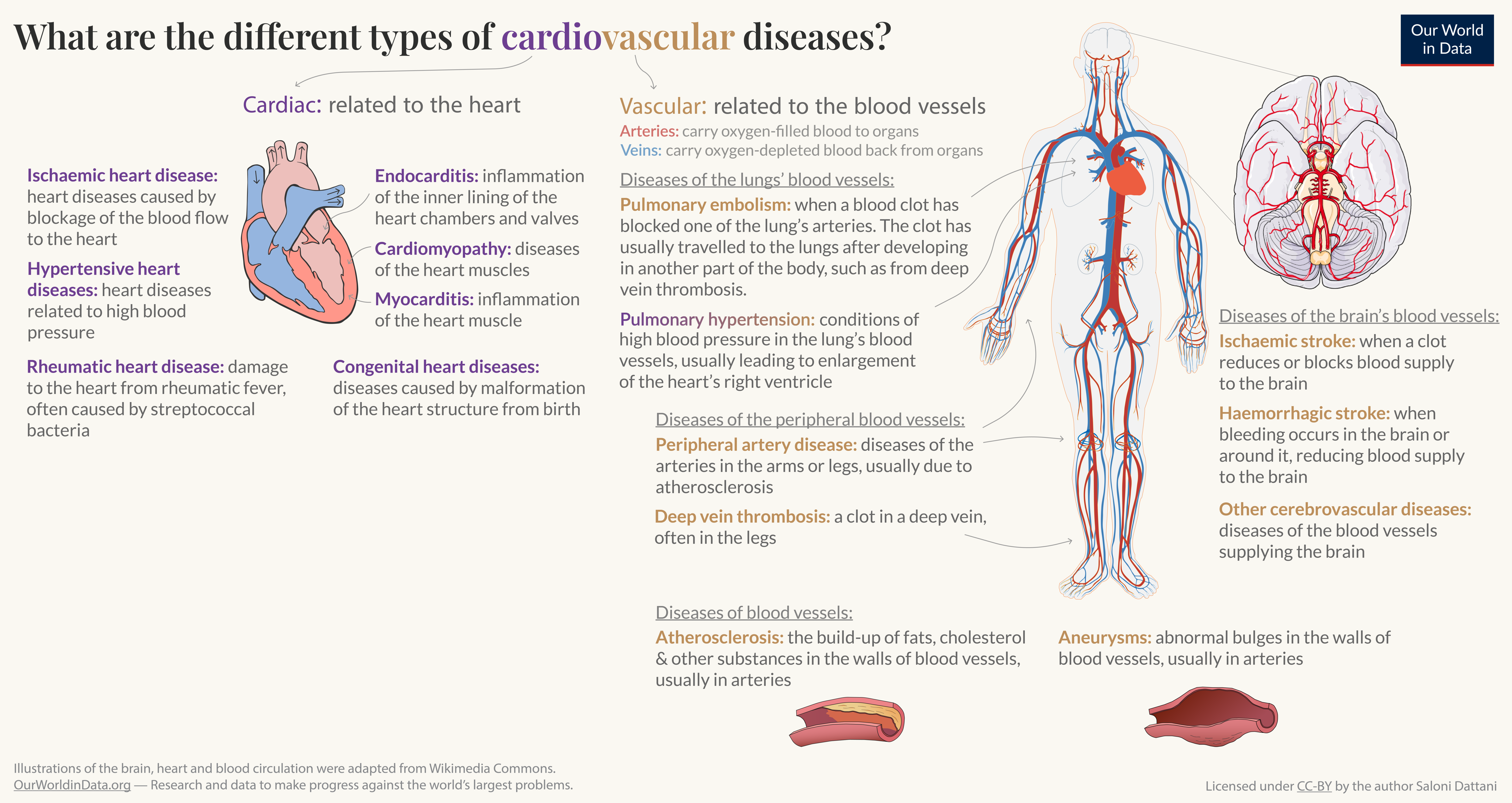
Saloni Dattani (2023) - “What are the different types of cardiovascular diseases, and how many deaths do they cause?” Published online at OurWorldinData.org. Retrieved from: 'https://ourworldindata.org/cardiovascular-diseases-types-and-death-tolls' [Online Resource]






Post comments